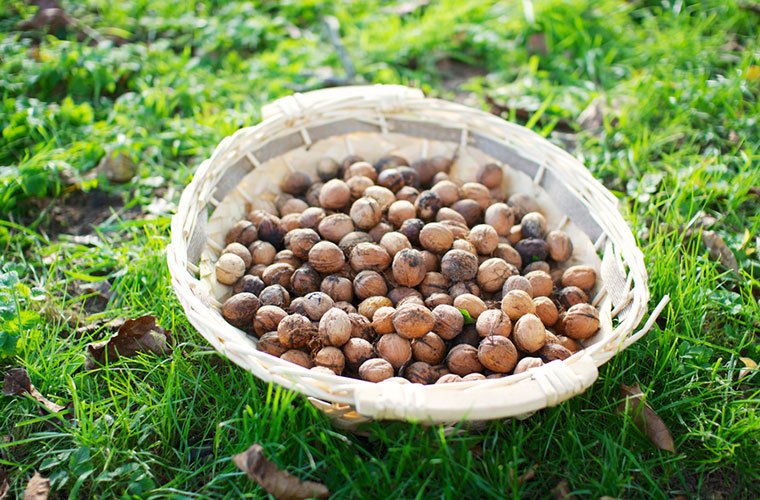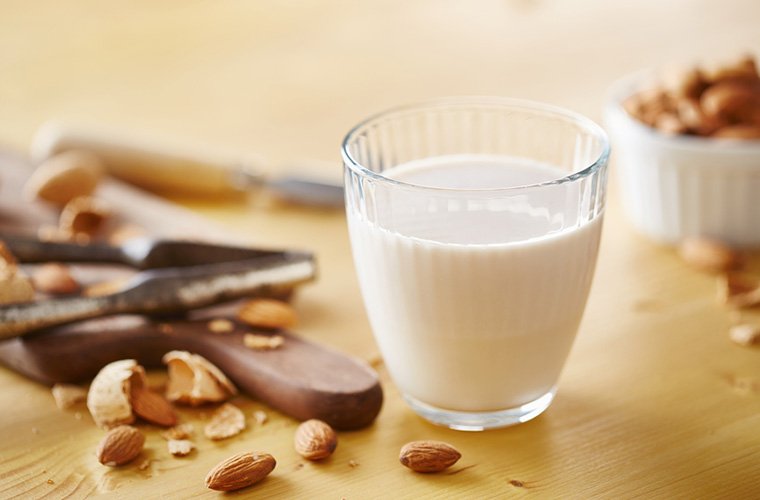When It Comes to Nut Milk, What’s the Most Sustainable Option?
You know a health-food trend has gone mainstream the second it winds up on a Starbucks menu. But when it comes to finding a dairy substitute that's good for you and the environment, not all nut milks are created equal.
Nutrition and taste are obviously huge factors for consumers, but there's something else to consider: sustainability.
Demand has made alternative milks a nearly $2-billion industry, with almond milk making up 60 percent of sales. But it's not breaking news that it takes a gallon of water to grow each almond, or that the vast majority of them are sourced from California—where there, ahem, happens to be a massive water shortage. So, what's an almond milk-loving healthy girl to do if she's looking for a more eco-conscious drink option?
Read on for five factors to keep in mind when choosing a sustainable nut milk.

1. Consider where the water is coming from
Rainfall plays a huge factor in a nut milk's sustainability, points out Milkadamia CEO Jim Richards (who, yes, definitely has his own biases). All nuts require a lot of water, but macadamias, coconuts, hazelnuts, and cashews (technically a drupe) can be sourced from places where H20 isn't scarce.
"There's nothing wrong with almond trees," he explains, "but 90 percent of the world's almonds are grown in California, in an arid region where they don't belong, so they have to suck water from underground reservoirs. And the word 'reservoir' comes from 'reserve'—that's water being reserved for California, and it's being used up [on] this one nut crop."
But the California Almond Board says the nut's reputation as a water hog isn't entirely deserved. "The drought in California has put a spotlight on almonds’ water use; however, many people don’t know that an almond tree uses about the same amount of water as most other California fruit and nut trees," says Molly Spence, the board's North America director. "Furthermore, California’s almond farmers take pride in using water as efficiently as possible. In fact, over the last two decades, we’ve reduced—by 33 percent—the amount of water it takes to grow a pound of almonds."

{{post.sponsorText}}
Still, given that tons of almonds are grown in the Golden State, it's clear how their production can be draining—which is why it's worth exploring more sustainable options for a dairy substitute.

2. Transportation plays a role, too
In an effort to steer clear of California's water shortage issues, some alt-milk manufacturers are sourcing their nuts overseas. The almonds for Malk Organics's nut milk, for example, are sourced from Spain. And Milkadamia's macadamia nuts are grown in Australia.
In some cases, says Malk founder August Vega (who has a background in energy sustainability and water efficiency), a larger shipping carbon footprint can mean a smaller environmental impact.
"Europe’s processing of nuts versus America’s is much more efficient, and Europe’s lack of chemical processing [makes] the nuts better for you. These are the two biggest factors that Malk considers when deciding where to source the nuts," she explains.
As a consumer, it's up to you to determine how you value where an ingredient is grown versus the distance it travels to get to you—but luckily, if a brand is going to great lengths to source its nuts, it typically says so on its packaging or website.

3. Support local nut milk makers—or craft your own
If you're not nuts about a brand going abroad for its ingredients, there are other options made closer to home to consider. For example, Vega also works with a nut that's native to Texas, where Malk is based, and doesn't require as much water as almonds: pecans. And "it requires a lot less fuel to get to us since they're grown here," she says.
Another way to reduce the carbon footprint of your nut milk is by looking for small-batch suppliers in your area. Or try making your own, which might be the most nutritious way to go as it gives you control over your milk's nut-to-water ratio—the average store-bought carton contains as little as two percent of actual nuts.
(If you're ready to DIY, there are recipes for homemade cashew milk, macadamia milk, and even pistachio milk.)

5. The best option might not be from a nut at all
When Ripple founder—and former climate scientist—Adam Lowry set out to make a plant-based milk, he didn't choose to use almonds, cashews, or even pecans. Instead he went with peas. Besides packing more protein than nuts, he says they're a lot more sustainable. "Peas are much better on a water and carbon basis," the entrepreneur explains, adding that they require 85 percent less water to grow than almonds.
Lowry also says soil health is another prong of sustainability consumers often forget to consider. "Peas pull nitrogen out of the air and make plant mass out of that, which means you don't have to put a lot of fertilizer on them—and fertilizer has a large carbon footprint," he says.
Regardless of which alt-milk you reach for, there's one thing all the experts here agree on: supporting companies that prioritize sustainability is definitely a good thing. "Business is the largest and most powerful institution on the planet and really has the obligation to carry out social and environmental stewardship," Lowry says.
Using your dollars to support a business bettering the earth? Now that's something that does the body good.
Take your relationship with alt-milk to the next level by discovering vegan cheese, or try out this super-easy vanilla quinoa milk recipe that's also packed with protein.
Loading More Posts...
